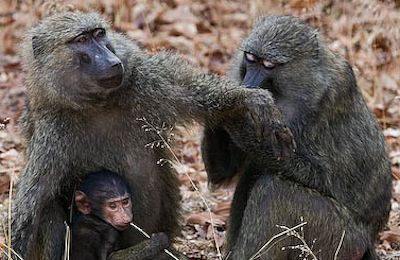 Olive baboons some of the best tourist attraction on a Rwanda Primate Safari are also referred to as the Anubis baboon and it belongs to the world’s old monkey family called the cercopithecidae and this is the biggest specie of baboons. Olive baboons are usually found in about 25 countries in Africa more so in the countries with forested areas like Rwanda, Uganda, Tanzania, there are lots of these monkeys in Mali, Ethiopia and other mountainous areas of the Sahara. They are called the olive monkeys because their coat color.
Olive baboons some of the best tourist attraction on a Rwanda Primate Safari are also referred to as the Anubis baboon and it belongs to the world’s old monkey family called the cercopithecidae and this is the biggest specie of baboons. Olive baboons are usually found in about 25 countries in Africa more so in the countries with forested areas like Rwanda, Uganda, Tanzania, there are lots of these monkeys in Mali, Ethiopia and other mountainous areas of the Sahara. They are called the olive monkeys because their coat color.
How and where they live.
Olive baboons just like all primates live in the forests and normally in a group of about 15 -50members but sometimes they can increase up to 150members and majority of them are usually females with only a few males along with the young ones. In every group, there is ranking among the members and it all depends on the dominance. When it comes to female dominance, it is hereditary which means the mothers and daughters are almost on the same rank although, it is still the grown-up females that are the core of the family.
The related females are often friendly to each other, stay close to each other and groom each other. Groups split when they become big in size and start competing for resources. Normally, the males are more dominant in the group, they are often competitive amongst each other all in an effort to get access to the females.
The male baboons are ready to leave their troops when they are 4 years old while the females stay with the troop.
What they feed on.
They are omnivorous so they feed on leaves, grass, fruits, seeds, tubers, flowers and lots of other vegetations. During the times of droughts when the green is scarce, they feed on corns and rhimones. They also feed on insects like scorpions, spiders, also the small mammals, birds, among so many others.
How they reproduce and nature.
At about seven years or eight when ovulation starts, the females are ready to reproduce while the males mature at 10 years. The females will exhibit signs like the swelling and redness of the private areas once they are ready to reproduce and those that have more swelling tend to produce more young ones which have more chances of surviving.
There is always a lot of competition among the males for the females and once a female is pregnant, the gestation last about 180 days after which it will give birth to only 1 infant.
During the time of conception, the male will protect its female from all other males mating with her. The new ones are born with black natal coats, the mothers are the main care givers and it’s true that one female can take care of another’s little one. The little ones heavily rely on their mother for physical support during the first days after birth but they will be ready to support themselves after two weeks. But they continue to get protect from their parents especially against the predators like the chimpanzees, lions, African wild dogs, crocodiles, hyenas and other stronger animals.
Olive baboons are very common in places like the Nyungwe forest of Rwanda and a primates tour will be a very rewarding to anyone who is interested in meeting these primates in their natural settings which is the jungle. During the trek in the jungle, you will be amazed by what you will see like different monkeys, different tree species, and lots of birds, among so many others.


UGANDA SAFARI PACKAGES :